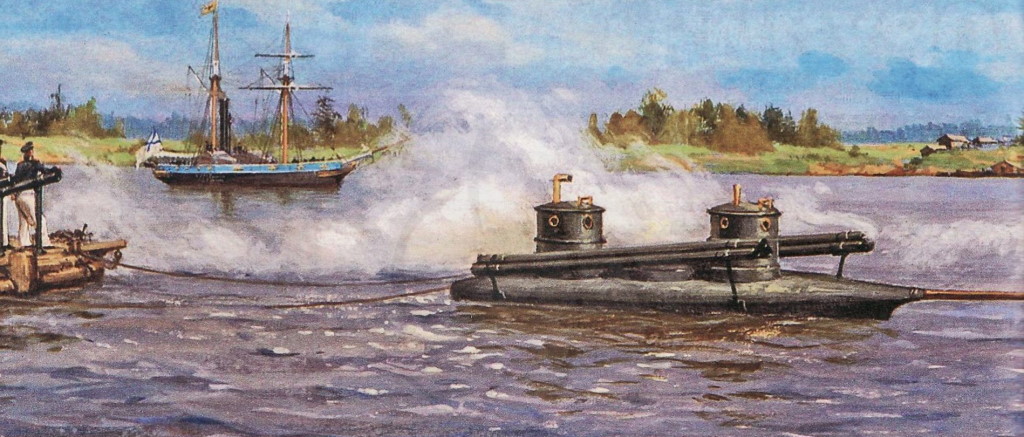
Engineer-General Karl Andreevich Schilder is credited with
having constructed the first submarine in Russia with an iron hull. Built at
the Alexandrovsky Works plant in St. Petersburg and completed in May 1834. The
boat had an egg-shaped form, two towers with access hatches and was equipped
with an optical viewing tube, one of the first periscope devices for
submersibles. An armament of mines and two triple-tube mountings for launching
rocket projectiles was to be provided. To defeat an enemy vessel by using the
mine it was necessary to stick a core of the mine in a hull, to move away to a
safe distance and to blow up the mine by electric fuse.
Trails took place in September 1834 on the Neva River and
the nearby island of Kronshtadt in the Gulf of Finland. The craft demonstrated
an ability to submerge and was judged quite successful. An improvement version,
equipped with diving plane to help control the craft underwater, was
constructed in 1835, and with this second boat Schilder successfully destroyed
a target ship with a mine in July 1838.
Trails with this boat were regularly conducted near
Kronshtadt through 1841, but after some unexplained failure during trails in
the fall of that year, Schilder was ordered to halt further experiments-as the
boat was recognized unable for combat purposes. Lieutenants Zhmelev and
Adamopulo were the first submarine commanders in Russia.
Specifications Schilder’s design (1834):
Displacement (srf/sub tons): un known
Dimensions (L*B*D feet): 19’8*4’11*6’6
Propulsion: man-powered “vanes”, akin to fish fins
Speed (srf/sub knots): un known /1.5
Range (srf/sub n/miles@knots): un known
Diving depth (feet): 40
Complement: 1 crew member
Torpedo: none
Mines: several
Armament: 2
triple-tube mountings for launching rocket projectiles
Karl Andreevich Schilder
Born Dec. 27, 1785 (Jan. 7, 1786), in the village of
Simanovo, in what is now Nevel’ Raion, Pskov Oblast; died June 11 (23), 1854,
in Călărasi, Rumania. Russian military engineer. General of the engineers
(1852); adjutant general.
Shilder graduated from a school for column leaders in 1806
and served in the engineer troops as commander of a sapper company and a
battalion and as chief of engineers of a corps and of an army. He fought in the
battle of Austerlitz (1805), the defense of Bobruisk (1812), the Russo-Turkish
War of 1828–29, and the Crimean War of 1853–56. He distinguished himself in
action during the siege of Varna in 1828, the sieges of Silistra and Sumla in
1829, and the forcing of the Danube in 1854. Shilder died of wounds received at
Silistra during the Crimean War of 1853–56.
Shilder developed a new and more effective system of
countermining, using horizontal and inclined passages rather than vertical
shafts. He also devised antipersonnel mines, stone fougas-ses, and canister
mines. He produced an original design for a suspended rope bridge in 1828 and a
“wineskin bridge” of quickly assembled, portable pontoons made of rubberized
canvas in 1836. Between 1832 and 1836, Shilder and P. L. Shilling developed a
method of setting off powder charges electrically. Between 1838 and 1848, Shilder
and B. S. Iakobi built electrochemical and electrochemical-contact naval mines.
Shilder provided the designs for the world’s first all-metal submarine, built
in 1834, and the Otvazhnost’, built in 1846; the world’s first steamship armed
with artillery and rockets, the Otvazhnost’ was a prototype of the destroyer.
Among Shilder’s students were the talented engineers E. I. Totleben and M. M.
Boreskov.
REFERENCE
Maziukevich, M. N. Zhizn’ i sluzhba general-ad”iutanta K. A.
Shildera. St. Petersburg, 1876.
Iakovlev, V. V. Kratkii ocherk istoriipodzemnoi minnoi
voiny. Moscow, 1938.